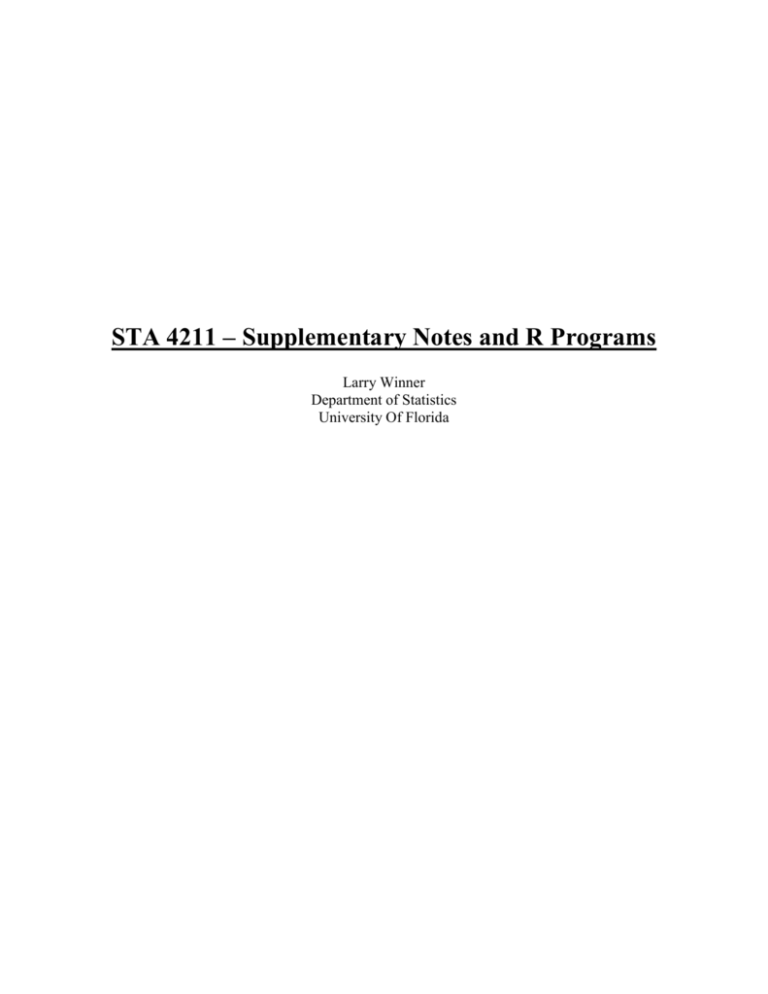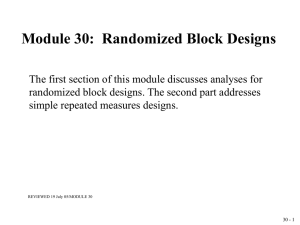notes_a - Department of Statistics
advertisement

STA 4211 – Supplementary Notes and R Programs Larry Winner Department of Statistics University Of Florida Introduction to Experimental and Observational Study Design • • • • Experimental Studies – Units (aka Subjects in human studies) assigned at random to treatments/conditions Experimental Factors – Conditions with 2 or more levels, which are assigned to units. If there is more than one factor, treatments are combinations of factor levels assigned to units. Observational Studies – Units are sampled from two or more populations/subpopulations Observational Factors – Set of levels of Populations/subpopulations used in the study Causation is directly obtained in Experimental Studies, not in Observational Studies Mixed Designs Experimental & Observational Factors Example: Effects of Container Size on Food Intake A study was conducted to compare three conditions on food intake in students. A sample of 88 subjects was obtained, and randomly assigned to one of 3 conditions involving bowl size and portion of M&Ms while watching a television program: 1) Medium portion size/Small container (n1 = 30), 2) Medium portion/Large container (n2 = 29), and 3) Large portion/Large container. Researchers measured the food intake among the students. Note that this is an Experimental Study, as Subjects were assigned at random to treatments. Example: Waste in Mediterranean Sea at 14 Locations A study measured the amounts of Natural and Artificial floating debris at samples of transects at 14 locations in the Mediterranean Sea. The researchers wished to compare the amounts of debris of each type among the locations. Note this is an Observational Study, as transects were sampled within the selected locations. Example: Quilting Layers in Body Armour A study was conducted to determine whether the number of quilting layers improved the fragment protective performance of body armour. The researchers sampled 36 specimens of each number of layers (1,2,3, and 5), assigning 12 at random to each of 3 bullet impacts (slow, fast, and edge). The energy absorbed by each specimen was measured. Note this is a Mixed Design, as Layers is Observational, and Impact is Experimental. Basics of Experimental Studies • • • • • Explanatory Factors – Conditions (with 2 or more levels) that are assigned to units. Crossed Factors – Factors with levels that are the same within levels of the other factor(s) Nested Factors – Factors with levels that are different within levels of the other factor(s) Treatments – Combinations of factor levels given to units Experimental Units – Units used in the study, which are subject to randomization to treatments. Randomization Process - Use of random number generator to assign units to treatments Outcome measurement(s) obtained from treated units Example: Reading Times on 3 Electronic Readers at 4 Illumination Levels An experiment was conducted, where 60 subjects were randomly assigned so that 5 received each of 12 treatments (combinations of 3 e-reader models and 4 illumination levels). The experiment was Crossed in the sense that each e-reader model was set at the same 4 illumination levels (200, 500, 1000, 1500Lx). The time to complete a reading task was the measured response. Example: Combability of Hair for 2 Shampoo Formulations An experiment was conducted to compare two shampoo formulations with respect to combability of hair. A sample of 16 hair swatches were created and randomly assigned, such that 8 received shampoo A, and 8 received shampoo B. Each swatch was washed 5 times, and the combability was measured. The experiment was Nested, as the swatches receiving shampoo A were different from the swatches receiving shampoo B. Note that the swatches are the experimental units, as they are randomly assigned to treatments (shampoos). The relicates measured are the measurement units. Completely Randomized and Block Designs • Experiment with One Factor @ 2 Levels (Treatments) • Completely Randomized Design – Take all subjects, and randomize so that (typically) half receive Trt A, and the other half receive Trt B Yi = 0+1Xi1+i • where: Xi1 = 1 if subject i received A, 0 if B Randomized Block Design – Generate blocks of subjects that are similar wrt external criteria (gender, age,…) and randomize treatments to subjects within blocks. Helps make treatment groups more similar. Note that in many studies, the subjects are the blocks (receiving each treatment). Y = Overall Mean + Trt Effect + Block Effect + Error Example – Comparing 2 Methods of Teaching Metaphors to Children A study was conducted to compare 2 methods of teaching children (process vs basal instruction). A sample of 53 children was obtained and randomized so that 27 received process instruction, and 26 received basal instruction. The response measured was the number of correct metaphors identified (out of 8 possible). With 2 groups, this can be analyzed by an Independent Samples t-test. Example: Comparison of Professional and Recreational Investors in Betting Market A study compared mean return in betting among remote (typically “professional” bettors) and attendee (typically “recreational” bettors). The blocks were 2057 races where average returns were obtained for each betting group (Remote, Attendee). The treatment effects were Remote and Attendee, and the block effects were the individual races. With 2 groups, this can be analyzed as a paired t-test. Standard Experimental Designs • Completely Randomized Design (CRD) – Units randomized to treatments with no restrictions on randomization process • Factorial Experiments – CRD with two or more crossed factors. Treatment effects are made up of main factor effects and interaction effects • Randomized Complete Block Design (RCBD) – Units are grouped into blocks. Treatments randomly assigned to units within blocks • Nested Designs – Levels of Factor B differ across levels of Factor A • Crossed/Nested Designs – Designs with both crossed and nested factors • Repeated Measures Designs – Each unit is measured multiple times • Each subject receives each treatment once (similar to RCBD, and analyzed the same way) • Each subject receives only one treatment, but is measured at multiple time points (extension of CRD) • Split-Plot Designs – Two (or more) sizes of experimental units due to randomization restrictions for factors • Incomplete Block Designs – Block Designs with block sizes smaller than the number of treatments • 2-Level Factorial Experiments – Several (possibly many) factors, each at 2 levels (low/high). With k factors, there will be 2k treatments • 2-Level Fractional Factorial Designs – Experiments with only a subset of all 2k treatments to reduce cost, but still obtain estimates of main effects and lower-order interactions • Response Surface Designs – Designs used to fit polynomial regression models for numeric factors Example: Advertising Message Strategy and Attitude Towards the Firm An experiment was conducted to compare 4 advertisement conditions. A sample of 425 students were selected and randomly assigned to one of 4 conditions. The ads were: Ad1: Firm as "pioneer of industry standards in social responsibility" and US location Ad2: Young woman partially clothed in shower, winner of wet t-shirt contest Ad3: Female co-founder of porn mag for women, in jogging shorts/hoodie Ad4: Female and male partially clothed couple in bed, faces cropped out of image. Female on top of male. The response was an overall attitude toward the firm based on a series of rating items. Note that each student was exposed to only one condition. Condition 1: Ad1 Only, Condition 2: Ad1&Ad2, Condition 3: Ad1&Ad3, Condition 4: Ad1&Ad4. Example: Energy Efficiency of 4 Dryer Types and 3 Clothing Categories A study compared combinations of 4 dryer types (1=Electric Dryer, 2=Bi-directional Electric dryer, 3=Town Gas-Fired Dryer, 4=LPG-Fired dryer) and 3 Clothing Types (1=Towels, 2=Jeans, 3=Thermal Clothing) on Energy Efficiency (kWh/kg). There were 3 replications per treatment. Example: Comparison of 6 Chopstick Lengths on Feeding Efficiency A study compared 6 chopstick lengths (180, 210, 240, 270, 300, 330mm) in terms of the numbers of peanuts picked up and placed in a cup. There were 31 subjects, and each subject used each chopstick. The subjects act as blocks. This can also be treated as a Repeated Measures Design, where each subject receives each treatment. Example: Caffeine Content of Coke and Pepsi Formulations at Various Restaurants A study compared Coca-Cola and Pepsi-Cola at various restaurants with respect to caffeine content. There were 5 restaurants that sold Coca-Cola brand (1=Red Lobster, 2=Applebees, 3=McDs, 4=BK, 5=Hardees) and 7 that sold Pepsi products (6=Arbys, 7=Subway2, 8=Subway1, 9=KFC, 10=PizzaHut, 11=TacoBell, 12=Wendys). Each restaurant sold both sugar and diet formulations. There were 10 measurements per restaurant per formulation. Note that restaurant is nested within brand, but crossed with formulation. Example: Zylkene v Placebo for Cats with Anxiety Over Time A study compared the effects of Zylkene v Placebo in cats with anxiety. A sample of 34 cats with anxiety was obtained, and randomized to receive either Zylkene or Placebo (17 cats per treatment). Each cat was observed on a global anxiety scale at each of 5 time points. The goal is to compare the treatments and determine whether time effects occur, and whether the treatment effects differ over time. Example: Effects of Seeding Rates of Hardinggrass and Ryegrass on Growth An experiment was conducted to measure the effects of 4 rates of seeding of the perennial hardinggrass (whole plots, with levels of 1,2,3,4 pounds per acre), and 6 rates of seeding of ryegrass (subplots with levels of 0,3,6,9,12,15 pounds per acre). The experiment was conducted in 3 blocks (replicates). The response measured was the density of hardinggrass. Note that the experimental units for levels of hardinggrass are larger than those for levels of ryegrass. Example: Consumer Liking of 20 Coffee Formulations An experiment was conducted to compare computer liking among 20 coffee formulations. As consumers have quite different tastes and preferences, they are treated as blocks. However, due to fatigue, the researchers had each consumer rate only 4 coffee formulations. In a balanced experiment, each formulation would be rated by the same numbers of consumers, and each pair of formulations would be tasted by equal numbers of consumers. Example: Using Seaweed to Extract Phenol from Aqueous Solution An experiment was conducted to study the effects of 3 factors (pH (3, 9), adsorbent dosage (1, 10 g/L), and temperature (30, 60C)) on phenol extraction efficiency (%) from an aqueous solution. Dried seaweed was treated with zinc chloride, then applied to one of the 8 combinations of the 3 factors. There were two replicates at each factor level. Example: Factors Affecting Damage to Motorcycle Wheels An experiment was conducted to determine the effect of 5 factors on the Crush Radius on the front wheel of a motorcycle. The factors were: Impact speed (3, 6), Impact Mass (51.18, 101.33), Tire Pressure (148, 252), Striker Contact Geometry (0.03, 0.10), and Impact Offset Distance (0, 0.108). Although there are 25 = 32 combinations of the factors, the experimenters ran it in 25-1=16 combinations to reduce costs. There were four replicates at each combination of factor settings. Example: Optimizing Qualities of Potato Chips An experiment varied 3 factors: Vacuum microwave pre-drying time (0.95, 3, 6, 9, 11.05 minutes), Vacuum temperature (83.18, 90, 100, 110, 116.82C), and Frying Time (11.59, 15, 20, 25, 28.41 minutes). Three responses were measured (analyzed one at a time): Moisture Content, Fat Content, and Breaking Force. The goal was to choose factor levels that optimize the response. Observational Study Designs • Cross-Sectional Studies – Observations made from populations/subpopulations at a single time point or interval. • Prospective Studies – Groups are formed by levels of a potential causal factor, then observed over time for some measurable outcome. • Retrospective Studies – Studies where subjects are identified based on the outcome of interest, potential risk factors are identified that previously occurred • Matching – Subjects from different populations are matched, based on external factors – like blocking Example: Medical Profession Students Attitudes Toward Interdisciplinary Studies A survey was conducted to measure students’ in medical professions Readiness for Inter-Professional Learning (RIPLS). Students were sampled from 3 groups: Nursing, Science in Surgical Technology, and Medicine, and given the scale measuring their readiness. This was cross-sectional in the sense that it was taken at one point in time. Example: Blood Transfusions and Caesarean Deliveries in 3 Pakistan Hospitals A prospective study was conducted to compare birth deliveries in 3 Pakistan hospitals over the period of January-June 2010. In particular, the authors were interested in the mothers who had Caesarean Sections (CS) and whether the patient had a subsequent blood transfusion. Example: Fertilization Time-Lapse Variables and Embryo Sex A study at a University-affiliated private fertility center considered the gender of an embryo, as well as various cleavage timing variables (from the time of the fertilization) retrospectively. The researchers were interested in determining whether any of the timing variables could predict the eventual sex of the embryo. Example: Recidivism Rates for Juvenile Offenders A study compared recidivism rates among juvenile offenders in 2 conditions: transferred to adult court and not transferred to adult court (tried in juvenile court). A database of past criminal record including number and severity of prior and current charges, gender, and age was created, and matches were created where within each pair, one had been transferred, the other had not. Subsequent recidivism was observed within each pair. Data Sources: Effects of Container Size on Food Intake D. Marchiori, O. Cornielle, and O. Klein (2012). “Container size influences snack food intake independently of portion size,” Appetite, Vol. 58, pp. 814-817. Waste in Mediterranean Sea at 14 Locations G. Suaria and S. Aliani (2014). “Floating Debris in the Mediterranean Sea,” Marine Pollution Bulletin, Vol. 86, pp. 494-504. Quilting Layers in Body Armour D.J. Carr, C. Lankester, A. Peare, N. Fabri, and N. Gridley (2012). “Does Quilting Improve the Fragment Protective Performance of Body Armour?," Textile Research Journal, Vol. 82, #9, pp. 883-888. Reading Times on 3 Electronic Readers at 4 Illumination Levels P.-C. Chang, S.-Y. Chou, K.-K. Shieh (2013). "Reading Performance and Visual Fatigue When Using Electronic Displays in Long-Duration Reading Tasks Under Various Lighting Conditions," Displays, Vol. 34, pp. 208-214. Combability of Hair for 2 Shampoo Formulations M.L. Garcia and J. Diaz(1976). "Combability Measurements on Human Hair," Journal of the Society of Cosmetic Chemists, Vol.27, pp379-398. Comparing 2 Methods of Teaching Metaphors to Children J.R. Readence, R.S. Baldwin, M.H. Head (1986). "Direct instruction in Processing Metaphors," Journal of Reading Behavior, Vol. VXIII, #4, pp. 325-339. Comparison of Professional and Recreational Investors in Betting Market A.C. Bruce, J.E.V. Johnson, and J. Peirson (2012). “Recreational versus professional bettors: Performance differences and efficiency implications,” Economic Letters, Vol. 114, pp. 172-174. Advertising Message Strategy and Attitude Towards the Firm K. Hyllegard, J. Ogle, R-N. Yan (2009). "The Impact of Advertising Message Strategy - Fair Labour v. Sex Appeal - Upon Gen Y Consumers' Intent to Patronize an Apparel Retailer," Journal of Fashion Marketing and Management, Vol. 13, #1, pp. 109-127. Energy Efficiency of 4 Dryer Types and 3 Clothing Categories W.M. To, T.W. Yu, T.M. Lai, S.P. Li (2007). "Characterization of Commercial Clothes Dryers Based on Energy-Efficiency Analysis," International Journal of Clothing Science and Technology, Vol. 19, #5, pp. 270290. Comparison of 6 Chopstick Lengths on Feeding Efficiency S-H. Hsu and S-P.Wu (1991). "An Investigation for Determining the Optimum Length of Chopsticks," Applied Ergonomics, Vol. 22, #6, pp. 395-400. Caffeine Content of Coke and Pepsi Formulations at Various Restaurants A.N. Garand and L.N. Bell (1997). "Caffeine Content of Fountain and Private-Label Store Brand Carbonated Beverages," Journal of the American Dietetic Association, Vol. 97, #2, pp. 179-182. Zylkene v Placebo for Cats with Anxiety Over Time C. Beata, J. Cordel, N. Marlois (2007). "Effect of alpha-casozepine (Zylkene) on Anxiety in Cats," Journal of Veterinary Behavior: Clinical Applications and Research, Vol.2, Issue 2, pp. 40-46. Effects of Seeding Rates of Hardinggrass and Ryegrass on Growth A.M. Schultz and H.H. Biswell (1952). “Competition between Grasses Reseeded on Burned Brushlands in California,” Journal of Range Management, Vol. 5, #5, pp. 338-345. Consumer Liking of 20 Coffee Formulations B. Li, J.E. Hayes, and G.R. Ziegler (2014). “Interpreting consumer preferences: Physicohedonic and psychohedonic models yield different information in a coffee-flavored dairy beverage,” Food Quality and Preference, Vol. 36, pp. 27-32. Using Seaweed to Extract Phenol from Aqueous Solution A.Ranthinam, J.R. Rao, and B.U. Nair (2011). “Adsorption of phenol onto activated carbon from seaweed: Determination of the optimal experimental parameters using factorial design,” Journal of the Taiwan Institute of Chemical Engineers, Vol. 42, pp. 952-956. Factors Affecting Damage to Motorcycle Wheels K.S. Tan, S.V. Wong, R.S. Radin Umar, A.M.S. Hamouda, and N.K. Gupta (2009). "Impact Behavior Modeling of Motorcycle Front Wheel-Tire assembly," International Journal of Automotive Technology, Vol. 10, #3, pp. 329-339. Optimizing Qualities of Potato Chips X-j. Song, M. Zhang, and A.S. Mujumdar (2007). "Optimization of Vacuum Microwave Predrying and Vacuum Frying Conditions to Produce Fried Potato Chips," Drying Technology, Vol. 25, pp. 2027-2034 Medical Profession Students Attitudes Regarding Interdisciplinary Studies Z. Keshtkaran , F. Sharif , and M. Rambod (2014). “Students' readiness for and perception of inter-professional learning: A cross-sectional study,” Nurse Education Today, Vol. 34, pp. 991-998. Blood Transfusions and Caesarean Deliveries in 3 Pakistan Hospitals S. Ismail, S. Siddiqui, F. Shafiq, M. Ishaq, S. Khan (2014). “Blood transfusion in patients having caesarean section: a prospective multicentre observational study of practice in three Pakistan hospitals,” International Journal of Obstetric Anesthesia, Vol. 23, pp. 253-259. Fertilization Time-Lapse Variables and Embryo Sex F. Bronet, M-C. Nogales, E. Martinez, M. Ariza, C. Rubio, J-A. Garcia-Velasco, and M. Meseguer (2014). “Is there a relationship between time-lapse parameters and embryo sex?,” Fertility and Sterility, http://dx.doi.org/10.1016/j.fertnstert.2014.10.050 Recidivism Rates for Juvenile Offenders Bishop, D.M., C.E. Frazier, L. Lanza-Kaduce, and L. Winner (1996). "The Transfer of Juveniles to Criminal Court: Does it Make a Difference?" Crime & Delinquency 42:171-191.







